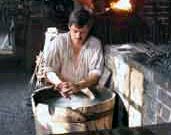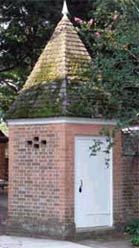To Bathe or Not to Bathe:
Coming Clean in Colonial America
by Edwards Park

Reenactors camped on Williamsburg's Market Square during
Publick Times help a youngster with her bucket bath.
--Dave Doody
It was a telling moment. During a reenactment, a few years ago, of the British occupation of Williamsburg in 1781, scarlet-clad British soldiers marched up Duke of Gloucester Street with shrilling fifes and thumping drums. And a foppish gentleman, playing the part of a rich Royalist, minced along beside them, but only after daintily plucking a lace handkerchief from the sleeve of his floral frock coat and clapping it to his nose.
The meaning of this little pantomime brought home to twentieth-century watchers the indisputable fact that eighteenth-century troops-American and French as well as British and German-stank. The citizens of Williamsburg would have smelled pretty ripe, too. Even the dandified Tory would have struck modern nostrils as noticeably aromatic. It's safe to assume that we would have found the entire Old Dominion-in fact, all thirteen colonies-afflicted with B.O. And since everyone stank, no one noticed it or recorded it for history. Sensitive souls might bury their faces in nosegays or scented hankies when a long-unwashed regiment tramped past, but most of our forebears remained as blissfully unaware of their stench as we are of the growing foulness of our air.
Ablutions were skimpy in those days. A little dab here and there with a damp cloth would do you, even in the fashionable capital of Virginia. To be sure, a so-called bathhouse, or bagnio, stands among the outhouses of the Governor's Palace. This little six-sided building, easily mistaken for a smokehouse or privy, existed as early as 1720, and Lord Dunmore, Virginia's last royal governor, was especially fond of it. He didn't use it to clean up, but to cool down.

Blacksmith Ken Schmarz takes a bar of lye soap to the grime on his hands. --Dave Doody
Dunmore was a Scot, his sturdy frame pulsing with good hot blood to keep him warm-even in a kilt-throughout the chilly damps of his native sod. Arriving in Virginia, he found the Tidewater's tropical summers unendurable. Other Britons, even from the more temperate climate of southern England, have shared this feeling through the years. Until the age of air-conditioning, staff members of the British Embassy in Washington were granted "hill leave" in the steaming summers. The expression came from British India where sweltering government servants were given this break to visit the cool hills. Washingtonians, of course, were outraged to find their climate bracketed with Calcutta's.
Lord Dunmore didn't go to Virginia's hills, except sometimes with his friend Colonel George Washington. But on hot days he repaired to his little bathhouse and sat naked in it while servants poured cool water over him. It must have felt wonderful, but whatever cleansing effect it had was only incidental.
In America's colonial days, getting clean meant sponging off, usually just face and hands. A few of the better homes furnished bedrooms with chinaware washbasins and pitchers. Servants supplied the water, heated in the kitchen or laundry, and laid out clean shifts for the ladies and fresh dress shirts for the gentlemen. A shirt concealed the sweat that often flowed beneath it and kept it from staining the elegant silk or velvet waistcoat and frock coat that went over it. If you were a wealthy man, you might have fifty shirts. Your lady, of course, didn't sweat. She merely glowed.
If you insisted on thoroughly washing, a wooden tub would do a fine job. But it required hard work. It had to be lugged from the laundry house, or wherever it was stored, and filled with water, hoisted from the well, that had to be warmed. Something had to be found to use as a towel. And where in the world did the homemade soap get to? With all this ado, a semblance of privacy had to be preserved during the adventure. So a good, soaking bath was a luxury of only the well served, and few of them tackled the job more than a couple of times a year. Everyone knew that too much bathing would destroy your natural oils and leave you wide open to the ravages of various diseases. Fortunately, that theory has changed 180 degrees since the eighteenth century.
In Williamsburg, shortly before the end of the eighteenth century, St. George Tucker installed the first copper bathtub recorded in the city. Tucker put it in his dairy, piping in hot water from the laundry in the servants' quarters. The cold water pipe came in from his well. After he'd splashed about in it and scrubbed himself, he'd vent the bathwater right out of the house.

Interpreter Brooke Barrows masks authentic odors with a nosegay.
--Dave Doody
Then there was the sort of bathing that we call swimming-just the sort of thing the eccentric William Byrd II would do.In his journal, this early eighteenth-century gentleman-scholar, owner of beautiful Westover, recorded his frequent swims in the James River, often accompanied by a generally dubious dinner guest.
Though this habit may have seemed to some of his neighbors a dire invitation to ague, Byrd often took his dips to cure just such an attack. He notes that a swim always left him feeling fine. He even braved the river in winter "without being discouraged by frost or Snow," according to a 1706 letter, and said that "If People would be persuaded to this, t'would save a world of Jesuits b ark and Starve all our Doctors." The bark was a medicine for malaria.
Williamsburg jurist George Wythe would have agreed. In his sixties he got into the habit of drawing several buckets of well water, filling a raised reservoir, and yanking a cord that dumped it gloriously all over him-a cold shower every morning, summer and winter. One of his law students wrote, "Many a time have I heard him catching his breath, and almost shouting with the shock." When the old lawyer bounded in for breakfast, "his face would be in a glow, and all his nerves . . . fully braced." Doubtless that's why Wythe, teacher of John Marshall, Henry Clay, Presidents Jefferson and Monroe, and other notables, lived to his eighties.

The hexagonal bathhouse, or bagnio, behind the Governor's Palace
was used more for cooling than cleanliness.
--Dave Doody
Up in New England, winter washing was a severe trial, and bathing was unthinkable. "When the temperature of a bed-room ranges below the freezing-point, there is no inducement . . . to waste any unnecessary time in washing," wrote Charles Francis Adams, grandson of President John Quincy Adams and brother of historian Henry Adams. Hence the Yankee yarns about springtime baths that laid bare Grandpa's long-lost long johns.
Clearly, colonial America was grungy. So was the rest of the young British Empire of that time-nowhere near as clean as its much-respected progenitor, the ancient Roman Empire. To a Roman of gentle birth, the high point of each day was the visit to the bath. Built over hot springs, and designed to look grand and beautiful, baths offered pools of cool, temperate, and hot water, fed by wooden or earthenware pipes. You strolled among friends in the sunny courtyards, making sure you were seen with, and by, the right people. Political deals sprouted in the great baths. Senators whispered to special interest spokesmen-the lobbyists of that day. Conversations continued in the steam room as puffy politicians and their backers sweated out the effects of high living. Bath attendants were everywhere: one to massage; another to oil, then gently scrape the bather's skin; yet another to pluck out obtrusive hairs.

An eighteenth-century French engraving of the joys of a bath.
-- Colonial Williamsburg
These temples of euphoria required the barest minimum of physical activity on the part of their patrons. But they sprang from the gymnasia of ancient Greece which were devoted to hard exercise. Here young men stripped-gymnos means "naked"-then, glistening with olive oil, boxed, wrestled, threw the discus or javelin-anything to work up a sweat and avoid much-dreaded flab. The ancient athletes exhausted themselves, then scraped off the oil, bathed, and, refreshed in body and mind, joined a group of listeners clustered around some noted philosopher like Socrates or Plato.
Archaeologists are often surprised by so many evidences of ancient cleanliness. Findings indicate systems of terra-cotta plumbing, with bathtubs made for royalty that look about the same as today's. The rich and powerful of three thousand years ago even enjoyed toilets that flushed with a controlled rush of rainwater. The Bible makes clear that if you wash someone's feet-and, if you're a woman, dry them with your hair-you've humbled yourself in a suitably Christian way. But the long tradition of sybaritic Roman bathing was enough to put baths into disrepute among early Christians. Only the monks kept the idea alive during the Dark Ages.
Monasteries often had communal baths, much simplified versions of Roman ones, with warmed water to make life a little more bearable for good monks, and cold to chill off naughty ones. Ordinary, unsanctified people had few chances for bathing, but at least the concept of large, public baths survived for a time in Europe. Fear of catching the Black Death, along with a growing shortage of wood for heating water, virtually ended public bathing. For a couple of centuries, common folk remained the great unwashed.
But such uncommon folk as kings and popes fared better. In the sixteenth century, Pope Clement VII, a Medici, could revel in a marble bath with many of the features found in ancient Rome-hot and cold water, for example. And in England, Elizabeth I, after whom Virginia was named, found a bath befitting to a virgin queen and took to it once a month "whether she need it or no."

This nineteenth-century tub was one a fixture in the basement of Williamsburg's St. George
Tucker House, the first home in town known to have a bath with running water.
--Colonial Williamsburg
During the Roman occupation of Britain, hot springs in the southwestern part of England inspired several Roman baths. One splendid example, with dark blue water that reeked of sulfur, was rediscovered in the twelfth century and gained a reputation for healing rheumatism and gout. By the reign of the Stuarts, the town of Bath was becoming fashionable.Diarist Samuel Pepys visited in 1668, finding he must use the baths by appointment, before the crowds came-"very fine ladies; and in the manner pretty enough, only methinks it cannot be clean to go so many bodies together in the same water." He bathed, found the springs even in the temperate bath "so hot as the feet not able to endure," and, before taking the coach for home, spent a shilling "to make a boy dive in the King's bath."
Hot springs have always tempted people, even those wariest of getting wet. On the last leg of their voyage to the New World in 1607, the vessels Susan Constant, Godspeed, and Discovery put in at the Caribbean island of Guadeloupe. Skipper Christopher Newport thought, and doubtless prayed, that his weary and grime-caked passengers might bathe in the island's volcanic hot springs. They did, and, squeaky clean for at least a day or two, they continued their voyage to plant, at Jamestown, Britain's first permanent settlement in North America.
Among early American settlers, William Penn's Quakers espoused healthy habits of exercise and hygiene. Told that vigorous activity for children "fits them to bear the roughest Providences," Quakers quickly took to swimming and bathing. One, Elizabeth Drinker, had a shower put up, tried it, and noted, "I bore it better than I expected, not having been wett all over at once, for 28 years past." Lawrence Wright's delightful book Clean And Decent tells of Penn's butler, presumably a Quaker, who was not only deaf but plagued with various pains. "He leaped from his bed on a cold night, threw off his night shirt, jumped into cold water, ran naked round the garden, into the water again, twice more round the garden; then, taking 'a good swigg o brandy', back to bed-and needless to say had recovered both health and hearing by the morning."

When warm weather opened the bathing season and infirm eighteenth-century Englishmen needed "to take the waters," they made a beeline for Bath, as exaggerated in this farcical print. - Colonial Williamsburg
In 1775, George Washington took command of New England troops who had fought the American Revolution's opening battles and now surrounded Boston to keep the British cooped up there. The newly named American commander found his army an unruly gathering of restless young men in generally filthy and unhealthy camps. He wrote many letters to Congress about the need to change this situation before disease struck and, in one, approved of his men bathing in the Charles River. But, when it came to their "running about naked upon the Bridge, whilst . . . Ladies of the first fashion in the neighborhood, are passing over it," the general put his foot down.
Washington was an enlightened soldier, certain that troops needed washing whenever the chance for it came. "While you halt," he wrote in orders to a colonel under his command, "you will take every measure for refreshing your Men and rendering them as comfortable as you can. Bathing themselves moderately and washing their Cloathes are of infinite Service."
As the Revolution raged, the general somehow found time to share in the development of Berkeley Springs in the northeast corner of what is now West Virginia. Here, where mineral springs still maintain a flow of fifteen hundred gallons a minute at seventy-four degrees, Washington and friends founded a village and named it Bath. They may have been unaware-or simply not interested-that, late in the eighteenth century, itinerant evangelists denounced the place as a "Seat of Sin" for its horse racing, gambling, and other ungodly revelries. Though today's road maps call the town Berkeley Springs, it's still officially Bath.
St. George Tucker's Williamsburg tub was about as up-to-date as any American hygienic equipment in 1796. For this country was a long way from the days when its plumbing would be the cynosure of the world. In fact, the French were likely the leaders in the bathroom business. French royalty quickly caught on and eagerly accepted the Roman notion of voluptuous baths. All important visitors to Versailles had suites that included baths. French tubs and bidets were made for all who could afford them. Often, like Mr. Tucker's, they were metal-producing a happier feeling on the naked body than cold marble. Toilets were routine furnishings in French palaces and many chateaux. Some, by ingenious French engineering, could be flushed with running water indoors. This put the French bathroom a long step ahead of the facilities of a British manor, where in blunt, bulldog fashion the squire raised water with a pump and, in answer to nature's demands, strode outside to his "bog-house." Queen Victoria, ascending the throne in 1837, found not a single bathroom in Buckingham Palace. She bathed in her bedroom with a portable tub. How often? Records of such a personal nature are still silent. But every day found Napoleon soaking in a hot tub and Wellington in a cold one, and Wright suggests that perhaps Waterloo was won in the bathroom. Far away, the townsfolk of little Williamsburg slipped into the nineteenth century with at least one tub, a few showers, occasional water pipes, a wealth of necessaries, and a healthy certainty that, baths or no, they had helped America make a clean start in the world.
Edwards Park's article "The British in Williamsburg" appeared in the Autumn 1995 issue of this journal.
